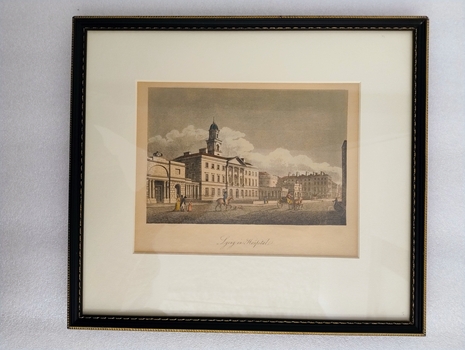Historical information
This is an image of the Rotunda Hospital in Dublin. Established as the Dublin Lying-In Hospital in 1745, it moved to its current location in 1757 and remains there to this day. This image was first published in Malton's 'A Picturesque and Descriptive view of the City of Dublin' in 1791.
Physical description
A colour engraving of a white building with a red roof. A tower, topped by a dome, rises above the middle of the building. There are four decorative columns on the front of the building, and the entrance to the building is surrounded by a metal fence. There are various figures in the foreground of the image. On the left, there is a well dressed family group consisting of three adults and a child. At left of centre, a figure is riding a horse, which is being preceded by a dog. At centre, in the middle background, one tall and one short figure stand next to the metal fence surrounding the building and are peering inside. At right of centre, a figure is driving a two horse buggy. On the far right, the shadowed figure of a beggar is holding out their cap.
There is a smaller building to the left hand side of the featured building, and additional buildings are visible in the right side background. Clouds are visible behind the buildings. Text below image reads 'Lying in Hospital'.
The print is mounted and framed in a black wooden frame with gold trim. A display label for this print is attached to the back of the frame. Handwritten inscriptions on the back of the frame of the artwork read 'Rotunda Lying in Hospital/Dublin // 19th British Congress RCOG 1971' and 'Original engraving/James Malton. London,/December 1795.' There is a sticker attached to the bottom right of the back of the frame featuring a printed image of a stork in read and the text 'FRIENDS OF THE ROTUNDA HOSPITAL'. There are two hooks and a wire attached to the back of the frame for hanging.
References
- Rotunda Hospital, 'History of Rotunda Hospital'
- National Library of Ireland, ' A picturesque and descriptive view of the city of Dublin displayed in a series of the most interesting scenes taken in the year 1791 by James Malton with a brief authentic history from the earliest accounts to the present time'




